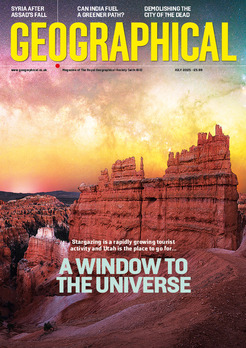
Scientists are probing ever deeper into the centre of the earth and making remarkable discoveries
In the remote Taklamakan Desert – a landscape of shifting sand dunes that extends over an area the size of Germany – Chinese engineers are digging an 11,000-metre-deep hole. Work began on the borehole in May. Once completed, it will be among the most ambitious projects to explore the world beneath our feet that has ever been attempted.
The deepest we’ve ever dug is the Kola Superdeep Borehole in northwest Russia, a 20-year Soviet project that was abandoned in 1995. At 12.5 kilometres deep, the hole reaches a third of the way through the Earth’s 40-kilometre-thick crust. Beyond that is the 2,900-kilometre-deep mantle, a largely solid layer of silicate rock.
In May, researchers onboard the JOIDES Resolution, the flagship of the International Ocean Discovery Program, finally retrieved a 1,000-meter-long rock core from the Earth’s upper mantle, successfully culminating 60 years of failed attempts. It could, they hope, help answer lingering questions about earthquakes and volcanic eruptions – a goal shared by the researchers in China.
Beyond this point, however, exploration remains all but impossible. That hasn’t stopped scientists from trying.
At the very centre of the Earth lies the core. This ‘planet within a planet’ – as University of Utah seismologist Keith Koper calls it – is thought to play an important role in making the planet habitable by deflecting the relentless solar wind, which would otherwise strip away our atmosphere (as it has on Mars). ‘The inner core is the main reason for the Earth’s magnetic field; it’s why life exists,’ says Guanning Pang, a postdoctoral researcher at Cornell University. ‘Yet we know very little about it.’

Pang has spent the last few years trying to see inside the Earth’s core. With no possibility of collecting a sample, scientists rely on seismic waves from naturally occurring earthquakes, which can be used to image the core’s texture – or fabric – and gain insights into its evolution. ‘This signal that comes back from the inner core is really tiny,’ says Koper. ‘What we’re doing is looking for a needle in a haystack. So these baby echoes and reflections are very hard to see.’
Since the 1930s, when Danish seismologist Inge Lehmann discovered that the Earth’s liquid outer core envelops a solid metal ‘marble’, we’ve thought of the Earth’s inner core as a spherical, homogenous mass. We now know that’s not the case. It’s more like a tapestry of different ‘fabrics’, says Pang, whose research has confirmed for the first time that this kind of inhomogeneity is everywhere inside the inner core. This suggests that the inner core, which grows about a millimetre each year as the entire Earth cools, may have grown more rapidly earlier in the Earth’s history.
At some point, it reached an equilibrium, and then started to grow much more slowly, says Koper. ‘Not all of the iron became solid, so some liquid iron could be trapped inside. ’Understanding the inner core is key to our understanding of the Earth’s formation and the workings of its magnetic field, which is known to shift around and sometimes even flip, causing the north and south poles to switch places. Its inaccessibility means that we may never fully understand it, however; we’ve already seen more of space than we may ever see of our planet’s interior. ‘It’s the most challenging part of our planet to study,’ says Pang, ‘but I still think there is more to discover.’




